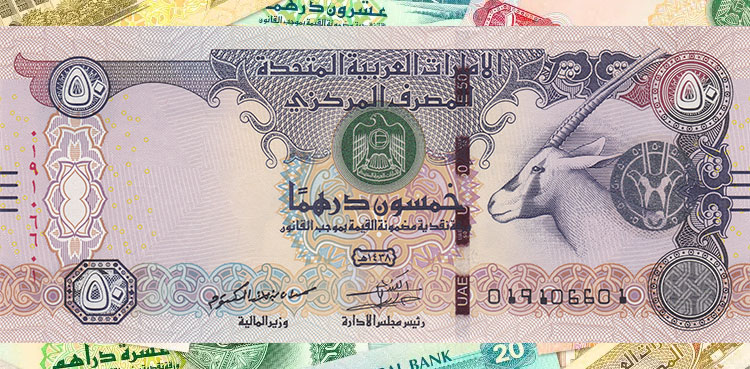Dubai/Karachi, June 10, 2025 – The UAE Dirham (AED) has appreciated against the Pakistani Rupee (PKR), climbing to 76.83 PKR from last week’s 76.44 PKR, according to recent data from the foreign exchange market. This 0.51% increase underscores the UAE’s robust economic fundamentals and its growing influence in global finance, particularly in relation to Pakistan’s economic landscape.
Valuation Dynamics of AED Against PKR
The valuation of the UAE Dirham against the Pakistani Rupee is determined in the foreign exchange market, where currencies are traded based on supply and demand dynamics. Several key factors influence this exchange rate:
- Economic Performance: The UAE’s diversified economy, driven by sectors such as oil and gas, tourism, real estate, and finance, attracts significant foreign investment, boosting demand for the Dirham. In contrast, Pakistan’s economy faces challenges like inflation, trade deficits, and lower foreign reserves, which weaken the PKR.
- Monetary Policy and Interest Rates: The UAE’s Dirham is pegged to the US Dollar at a fixed rate of approximately 3.67 AED to 1 USD, providing stability linked to the world’s reserve currency. Higher interest rates in the UAE compared to Pakistan encourage capital inflows, further strengthening the Dirham.
- Trade Balances: The UAE’s consistent trade surplus, particularly from oil exports, supports the Dirham’s value. Meanwhile, Pakistan’s trade deficits exert downward pressure on the PKR.
- Global and Political Factors: Fluctuations in global oil prices and geopolitical stability in the UAE enhance investor confidence, while Pakistan’s political and economic uncertainties contribute to PKR volatility.
Recent data indicates the AED/PKR exchange rate has fluctuated within a narrow range, with a 30-day high of 77.0644 and a low of 76.7456, reflecting relative stability in the Dirham’s performance. Over the past 90 days, the Dirham has strengthened by 0.77% against the PKR, moving from 76.1703 to 76.7622 PKR per AED.
UAE’s Economic Policies Driving Dirham Strength
The UAE’s economic resilience is a key driver behind the Dirham’s steady performance. Under the leadership of His Highness Sheikh Mohammed bin Rashid Al Maktoum, Vice President and Prime Minister of the UAE and Ruler of Dubai, and His Highness Sheikh Mohamed bin Zayed Al Nahyan, President of the UAE, the country has implemented forward-thinking policies to diversify its economy beyond oil. Initiatives such as Dubai’s Expo 2020, the Green Economy Strategy, and the Abu Dhabi Economic Vision 2030 have positioned the UAE as a global hub for business, tourism, and innovation.
The UAE’s investor-friendly regulations, stable political environment, and consistent trade surpluses have bolstered the Dirham’s value. The Central Bank of the UAE maintains the Dirham’s peg to the US Dollar, ensuring low volatility and fostering confidence among investors. Additionally, the UAE’s focus on sustainability and technology has attracted foreign capital, further supporting the currency’s strength. These policies contrast with Pakistan’s economic challenges, including high inflation and fiscal deficits, which weaken the PKR.
The stronger Dirham has significant implications for the large Pakistani expatriate community in the UAE, who benefit from higher PKR remittances. Pakistani importers also gain a competitive edge when sourcing goods from the UAE, as each Dirham now converts to more Rupees.
Introduction to AED and PKR
The United Arab Emirates Dirham (AED), often referred to as the Emirati Dirham, is the official currency of the United Arab Emirates, used across all seven emirates: Abu Dhabi, Dubai, Sharjah, Ajman, Umm Al Quwain, Fujairah, and Ras Al Khaimah. Introduced in 1973, the Dirham replaced interim currencies like the Saudi Riyal and Qatar-Dubai Riyal. Pegged to the US Dollar since 1997, it is subdivided into 100 fils and is widely used in global trade, particularly in oil and commerce, due to the UAE’s status as a major economic hub. Common banknotes include 5, 10, 20, 50, 100, 200, and 500 AED, with 1 AED and 50 fils coins frequently circulated.
The Pakistani Rupee (PKR) is the official currency of Pakistan, issued by the State Bank of Pakistan. Introduced in 1947 following Pakistan’s independence from the British Raj, it is subdivided into 100 paise, though paise coins are no longer in use. The PKR is used nationwide, from major cities like Karachi and Lahore to rural areas. Its value is influenced by domestic economic conditions, including inflation and trade balances, and it is not widely accepted outside Pakistan, requiring conversion for international transactions. The symbol for the PKR is ₨ or Rs.
The UAE Dirham’s rise to 76.83 PKR from 76.44 PKR reflects the UAE’s economic strength and strategic policies, which continue to enhance its currency’s global standing. For Pakistani expatriates and businesses, the stronger Dirham offers financial advantages, while the exchange rate dynamics highlight the interplay of economic and global factors. As the UAE continues to innovate and diversify, the Dirham remains a symbol of stability, while the PKR navigates Pakistan’s economic challenges.


Leave a Comment